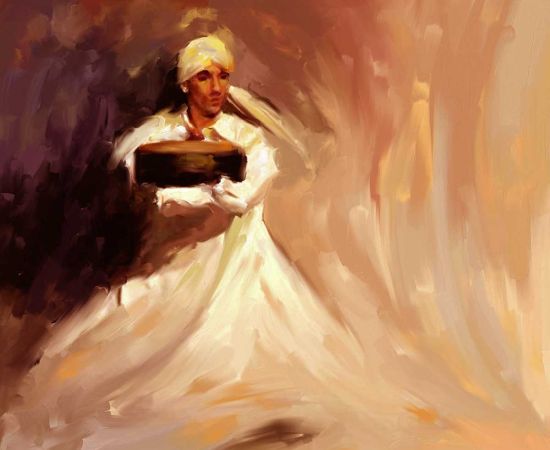More Coverage
Twitter Coverage
Satyaagrah
Written on
Satyaagrah
Written on
Satyaagrah
Written on
Satyaagrah
Written on
Satyaagrah
Written on
JOIN SATYAAGRAH SOCIAL MEDIA
“If it looks like a duck, quacks like a duck, it's a duck”: Mandarin duck is considered one of the most beautiful birds in the world, this is because of its stunning plumage, which is made up of an array of colors that you can't help but notice them

The mandarin duck (Aix galericulata) is considered one of the most beautiful birds in the world. This is because of its stunning plumage, which is made up of an array of colors that you can't help but notice. But there's more to this species than just flashy feathers. Whether it's their complex courting ritual or their cultural significance, there's a lot to know about the mandarin duck. Here are some of the most interesting facts about this colorful creature.
The mandarin duck (Aix galericulata) is a perching duck species native to the East Palearctic. It is medium-sized, at 41 – 49 cm in abbr=on long with a 65 – 75 cm in abbr=on wingspan. It is closely related to the North American wood duck, the only other member of the genus Aix. Aix is an Ancient Greek word that was used by Aristotle to refer to an unknown diving bird, and galericulata is the Latin for a wig, derived from galerum, a cap, or bonnet.
|
Description
The adult male has a red bill, a large white crescent above the eye, and a reddish face, and "whiskers". The male's breast is purple with two vertical white bars, the flanks ruddy, and he has two orange "sails" at the back (large feathers that stick up like boat sails). The female is similar to the female wood duck, with a white eye ring and stripe running back from the eye, but is paler below, has a small white flank stripe, and a pale tip to its bill.
Both the males and females have crests, but the purple crest is more pronounced on the male.
Like many other species of ducks, the male undergoes a moult after the mating season into eclipse plumage. When in eclipse plumage, the male looks similar to the female but can be told apart by its bright yellow-orange or red beak, lack of any crest, and a less pronounced eye stripe.
Mandarin ducklings are almost identical in appearance to wood ducklings, and very similar to mallard ducklings. The ducklings can be distinguished from mallard ducklings because the eye stripe of mandarin ducklings (and wood ducklings) stops at the eye, while in mallard ducklings it reaches all the way to the bill
|
Mutations
Various mutations of the mandarin duck are found in captivity. The most common is the white mandarin duck. Although the origin of this mutation is unknown, the constant pairing of related birds and selective breeding is presumed to have led to recessive gene combinations leading to genetic conditions including leucism.
Distribution and habitat
The species was once widespread in East Asia, but large-scale exports and the destruction of its forest habitat have reduced populations in eastern Russia and in China to below 1, 000 pairs in each country; Japan, however, is thought to still hold some 5, 000 pairs. The Asian populations are migratory, overwintering in lowland eastern China and southern Japan.
Specimens frequently escape from collections, and in the 20th century, a large, feral population was established in Great Britain; more recently, small numbers have bred in Ireland, concentrated in the parks of Dublin. Now, about 7, 000 are in Britain with other populations on the European continent, the largest of which is in the region of Berlin. Isolated populations exist in the United States. The town of Black Mountain, North Carolina, has a limited population, and a free-flying feral population of several hundred mandarins exist in Sonoma County, California. This population is the result of several ducks escaping from captivity, then reproducing in the wild. In 2018, a single bird, dubbed Mandarin Patinkin, was seen in New York City's Central Park.
The habitats it prefers in its breeding range are the dense, shrubby forested edges of rivers and lakes. It mostly occurs in low-lying areas, but it may breed in valleys at altitudes of up to 1500 m ft abbr=on. In winter, it additionally occurs in marshes, flooded fields, and open rivers. While it prefers fresh water, it may also be seen wintering in coastal lagoons and estuaries. In its introduced European range, it lives in a more open habitat than in its native range, around the edges of lakes, water meadows, and cultivated areas with woods nearby.
|
Breeding
In the wild, mandarin ducks breed in densely wooded areas near shallow lakes, marshes, or ponds. They nest in cavities in trees close to the water and during the spring, the females lay their eggs in the tree's cavity after mating. A single clutch of nine to twelve eggs is laid in April or May. Although the male may defend the brooding female and his eggs during incubation, he himself does not incubate the eggs and leaves before they hatch. Shortly after the ducklings hatch, their mother flies to the ground and coaxes the ducklings to leap from the nest. After all of the ducklings are out of the tree, they will follow their mother to a nearby body of water.
Food and feeding
Mandarins feed by dabbling or walking on land. They mainly eat plants and seeds, especially beech mast. The species will also add snails, insects, and small fish to its diet. The diet of mandarin ducks changes seasonally; in the fall and winter, they mostly eat acorns and grains. In the spring, they mostly eat insects, snails, fish, and aquatic plants. In the summer, they eat dew worms, small fish, frogs, mollusks, and small snakes. They feed mainly near dawn or dusk, perching in trees or on the ground during the day.
Threats
Predation of the mandarin duck varies between different parts of its range. Mink, raccoon dogs, otters, polecats, Eurasian eagle owls, and grass snakes are all predators of the mandarin duck. The greatest threat to the mandarin duck is habitat loss due to loggers. Hunters are also a threat to the mandarin duck because often they are unable to recognize the mandarin in flight and as a result, many are shot by accident. Mandarin ducks are not hunted for food but are still poached because their extreme beauty is prized.
Chinese culture | The Chinese refer to Mandarin ducks as yuanyang (), where yuan () and yang () respectively stand for male and female mandarin ducks. In traditional Chinese culture, mandarin ducks are believed to be lifelong couples, unlike other species of ducks. Hence they are regarded as a symbol of conjugal affection and fidelity and are frequently featured in Chinese art.
A Chinese proverb for loving couples uses the mandarin duck as a metaphor: "Two mandarin ducks playing in water" (). A mandarin duck symbol is also used in Chinese weddings because, in traditional Chinese lore, they symbolize wedded bliss and fidelity. Because the male and female plumages of the mandarin duck are so unalike, yuan-yang is frequently used colloquially in Cantonese to mean an "odd couple" or "unlikely pair" – a mixture of two different types of the same category. For example, the drink yuan yang and yuan-yang fried rice. Mandarin ducks featured on the flag of Weihaiwei during British rule.
Korean culture | For Koreans, mandarin ducks represent peace, fidelity, and plentiful offspring. Similar to the Chinese, they believe that these ducks mate for life. For these reasons, pairs of wooden-carved mandarin ducks called wedding ducks are often given as wedding gifts and play a significant role in Korean marriage.
Japanese culture | Similarly, in Japanese, the ducks are called and are used in the phrase.
|
8 Colorful Facts About Mandarin Ducks
Female Mandarin Ducks Lack the Males' Colorful Look
Mandarin ducks are known for their eye-catching look — their red bill; purple breast; the crest of black, green, blue, and copper; and golden-orange wings. And yet, that trait is not universal for the species. As with many other bird species, only the males have this eye-dazzling appearance, while female mandarin ducks have less eye-catching coloring. They have gray- or cream-colored feathers with bills to match.
That doesn't mean female mandarin ducks have no identifying features, however. Their eyes stand out because of a white ring that encircles them and then extends to a stripe along the face.
Male Mandarin Ducks Resemble Females When Molting
Like other waterfowl, the male mandarin duck molts its feathers after mating season. But it does not immediately return to its colorful glory. Instead, it molts into its eclipse plumage made up of brown and gray feathers, making it look like its female counterparts. Often, the only way to tell them apart at this time is to look at their bills — the males will retain the red beak that females lack.
In the fall, male mandarin ducks will molt again into their breeding plumage to prepare for the breeding season.
|
They Hail From East Asia, but Their Range Is Wide
Mandarin ducks are native to China, Japan, Korea, and eastern Russia, but habitat destruction has reduced the ducks' population in these areas. The good news is that the species can thrive outside of its native range. Populations can be found across Europe and the United States. This wide range is why, despite the global population decreasing, the IUCN categorizes the mandarin duck as being of the least concern.1
Their Range Increase Did Not Happen Naturally
While the mandarin duck is widespread, this expansion did not happen naturally. The ducks were imported to England in the mid-18th century because of their beautiful colors. However, they didn't begin to breed in the wild until the 1930s after escaping from private grounds. As of the mid-1980s, the British population was estimated to be approximately 7,000 ducks.2
Found in counties in North Carolina and California, the populations in the United States can likely be traced back to private collections. One male famously popped up in New York City's Central Park in October 2018, but no one knows how it arrived.
|
Mandarin Ducks Are Symbols of Love and Fidelity
Mandarin ducks are famous for being monogamous, meaning they mate for life. Because of this, the creature has become a symbol of love and fidelity for couples in China, Japan, and Korea. It's common for a pair of figurines of these ducks to be gifted to newlyweds, and they are often utilized as a feng shui cure to help maintain a healthy relationship.
There are references to the duck as far back as the beginnings of Buddhism; there is a legend in which a pair of mandarin ducks impress with their affection for one another.3 They appear in Japanese mythology and Confucianism as well.
They Have an Elaborate Courtship Ritual
While male mandarin ducks' colorful plumage helps them attract a mate, they still have to work for it. Like many other bird species, mandarin ducks perform a specialized courtship routine. The males shake, bob their heads, mock drink, and mock preen, all while raising their crest and orange "sail" feathers to show off. Despite being generally quiet creatures, they also incorporate sound into their courtship in the form of a whistling call.
Male Mandarin Ducks Are Absent Fathers
Despite being monogamous, mandarin duck pairs don't take on the duties of parenting equally. The male sticks around for the eggs' 28- to the 33-day incubation period, but once they are hatched, he leaves. The mother mandarin is left to rear the nine to 12 ducklings on her own.
Meanwhile, the male mandarin ducks molt into their eclipse plumage and, eventually, back to their breeding plumage to prepare for the following breeding season.
Newborn Mandarin Ducks Are Daredevils
A mother mandarin duck lays her eggs in the hollow of a tree up to 30 feet from the ground, but after the ducklings hatch, they quickly need to get to the water.4 The newborn creatures can't yet fly, but that doesn't stop them from finding their way to the ground. With the mother mandarin down below offering encouraging calls, each duckling takes a leap, launching itself out of the tree's hollow and free-falling to the ground. Grass and fallen leaves cushion their fall, and the baby mandarins emerge unharmed.
 Support Us
Support Us
Satyagraha was born from the heart of our land, with an undying aim to unveil the true essence of Bharat. It seeks to illuminate the hidden tales of our valiant freedom fighters and the rich chronicles that haven't yet sung their complete melody in the mainstream.
While platforms like NDTV and 'The Wire' effortlessly garner funds under the banner of safeguarding democracy, we at Satyagraha walk a different path. Our strength and resonance come from you. In this journey to weave a stronger Bharat, every little contribution amplifies our voice. Let's come together, contribute as you can, and champion the true spirit of our nation.
 |  |  |
| ICICI Bank of Satyaagrah | Razorpay Bank of Satyaagrah | PayPal Bank of Satyaagrah - For International Payments |
If all above doesn't work, then try the LINK below:
Please share the article on other platforms
DISCLAIMER: The author is solely responsible for the views expressed in this article. The author carries the responsibility for citing and/or licensing of images utilized within the text. The website also frequently uses non-commercial images for representational purposes only in line with the article. We are not responsible for the authenticity of such images. If some images have a copyright issue, we request the person/entity to contact us at This email address is being protected from spambots. You need JavaScript enabled to view it. and we will take the necessary actions to resolve the issue.
Related Articles
- In one of the rarest incidents wild mother elephant gave birth to twins in the Bandipur Tiger Reserve: Soon after the birth, the two toddlers joined their mother back in the herd
- “You can’t make a zebra by painting stripes on a horse”: Deep in the heart of Congo is a curious creature bit like a horse, a bit like a giraffe "Okapi", an artiodactyl mammal that is endemic to Africa, the Okapi is to the Congo what the Panda is to China
- “An animal’s eyes have the power to speak a great language”: Rare Himalayan Lynx found in Ladakh region of India, they occur throughout northern slopes of Himalayas and has been reported both from thick scrub woodland & barren, rocky areas above tree line
- “By discovering nature, you discover yourself”: Guide Anuradha Rao at Ross Island interacts with Animals, People from all over the world come to witness it, She is also one of the lucky survivors of the tsunami that devastated Andaman & Nicobar in 2004
- "An animal's eyes have the power to speak a great language": Shoebill - large, elusive, stalk-like bird with prehistoric appearance due to oversized shoe-shaped beak, usually silent but clatter their bills loudly during greetings sounds like a machinegun
- "A horse gallops with his lungs, perseveres with his heart, and wins with his character”: Shubhrak seeing his master in danger became uncontrollable and threw Qutubuddin on the ground, stomped his chest and head with mighty hooves killing him on the spot
- “The soul is stronger than its surroundings”: Breaking news: Scientists found proof of Pallas’s cat there in Nepal’s Sagarmatha National Park on the world’s highest mountain, Mt. Everest that brings to mind one of the most inhospitable places on the earth
- “Kerala is superbly seen from a saddle, or with a paddle. No hour of life is wasted there”: Alleppey, also known as Alappuzha, a picturesque town of #Kerala famous for its backwaters and serene beauty has fascinated tourists for its floating houses
- "And Freya the walrus, you slept your last because we loved you too much": Freya killed by Norwegian authorities after becoming a victim of her own popularity, 1320-pound female walrus was put down as an assessment concluded threat to human safety"
- "Curious case of Aarey metro Car Shed and NGO mafia peddled propaganda that green lungs of Mumbai will be destroyed": Bombay HC already rejected activists claim of Aarey being a forest, that’s why the name - Aarey ‘Milk’ Colony
- In a heartfelt farewell, Corbett Tiger Reserve Park says goodbye to Gomti, the devoted elephant, and Brandy, the faithful German Shepherd, their retirement tugs at heartstrings, reminding all of the deep bonds formed over years of dedicated service
- "There is no index of character so sure as the voice": Pahadi Mayna of Chhattisgarh reproduce an exact pronunciation as humans at times, it begin to learn human speech sounds under social relationships, for bird to talk you must intrude on its social life
- ‘Ghar baithe ganga aa gayi, Modi hai to mumkin hai’: Hundreds of people lined up, cheered with happiness celebrating as water reaches the dry barren land of Kutch via Narmada Canal, after 2 decade of protest by ‘andolanjivis’, Medha Patkar and her cronies
- "How dare you": EU Parliament declares nuclear power and natural gas as 'green energy' and investments in these sectors as climate-friendly, dubious environmentalist Greta Thunberg ranted on social media that it deepens the dependency on Russian fuels
- "Everything depends on this: a fathomless sinking into a fathomless nothingness": Joshimath sinking - 10 crore people visit Uttarakhand a year, how much can it take say experts, Nainital, Mussoorie, Dharchula and several towns could face similar disaster




























